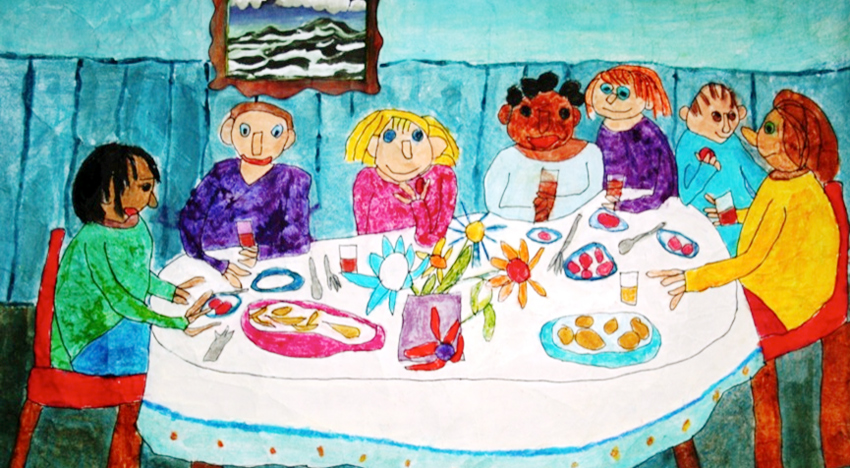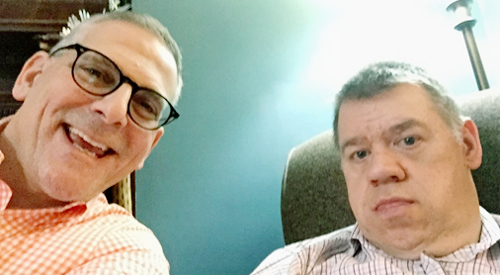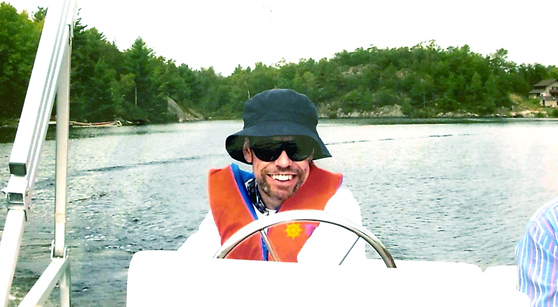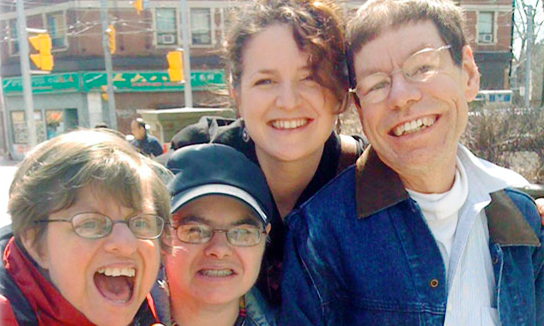Blog
Companions on the Journey: Part Two

Painting by artists of the atelier Le Pot-en-Ciel of L’Arche Montérégie
By Greg Lannan and John Guido
As we saw in the first part of our presentation to the Deeper Communion conference, the journey of friendship and belonging in community – with all of our differences – is the foundation for growth and discovery, for deep personal transformation. The road of transformation has its breakthrough moments, yet it takes many twists and turns along the way. That’s why we need to nourish ourselves and the fellowship we share.
The sacrament of everyday life
John explained, “The table is an essential space for building a vibrant community. It’s the place where we share our days and our lives, our laughter and our tears, as well as food and drink. It’s a place of welcome for visitors and new friends, as well as saying goodbye to those who are moving on. It’s a place for celebrating not only holidays and special events, but also the life-giving power of our ordinary days, those thousands of moments of risk-taking and trust-building between us.”
Greg named an important ritual of the table. “On birthdays and anniversaries, we pass the candle. We celebrate each person for who they are. We say what we like about the person. It helps you believe in yourself.” John added, “Henri Nouwen reminded us that the Latin word for blessing, benediction, mean to say a good word to a person, a word that blesses them to heal and grow.”
With support and affirmation from others, Greg discovered that he has a gift for walking with people in loss. He helped Jane Powell create a grief group and share her learning with others in talks and on the Aging and Disability website. It’s a gift that flows from the loss he lived as a child. Another ability he discovered as a child was his gift for art. “I can say what I want to say better through drawing than words,” he says. On the Aging and Disability website is a painting that brings these two gifts together as Greg explains a painting he created about grief.
Expanding the table
John also discovered his gifts for seeing the extraordinary in the ordinary things of daily life and using words to write about it through his own struggles. He reflected on the need to make the circle at our table more inclusive. “Greg and I are different, yet we also share our lives with people who have more significant disabilities like Tilly who lives with Greg and my buddy Michael.

Michael cannot speak with words though he does communicate what’s important to him. He expresses gratitude that we welcomed him from the institution and for his mom who fought to get him home. He has grown more secure and peaceful. He has a tremendous capacity for friendship and notices what people need before they ask. When I’m stressed, he helps me get grounded.
Michael also makes sure that we keep the traditions of the table. He brings the candle for prayer and when we pass the candle on special occasions, he always takes his turn to say his good word to the person. Like Greg, Mike knows what it’s like to be left out; he makes sure that we never forget to nourish community around the table.
The truth is that our L’Arche table can be boring; we can just be going through the motions. It takes commitment to celebrate the ordinary or we can miss its power. Our tables can also be chaotic or filled with tension. It isn’t always easy to be together with all of our differences. Forgiveness is just as important as celebration to community life.
With attention, a deeper truth is revealed. In order for each person to be welcomed to their rightful place at the table, we must stop trying to change people and instead change the table. We still want to respect each other and make the table safe for all to be present. Yet when we get the balance right between the needs of the group and our desire that each person’s unique light shines, the table changes. It’s transformed.”
The journey to freedom

This journey of friendship and belonging takes us to a place of deeper freedom to accept ourselves and others as we are with all of our strengths and all of our limitations, to accept life as it is with all its joys and all its sorrows. Greg said, “Freedom is when you can tell each other about yourself. Not to be afraid of being you – which is the hardest person to be sometimes.”
For the past few years, Greg has been thinking and talking to John about freedom in a new way – and he is beginning to live with a greater freedom to be fully himself. Here is an image he has used to explain what he is thinking about:
“I drew the picture of the butterfly and the tree to talk about Freedom.
- We have to be free to be the butterfly. It’s small, sometimes weak. It can fly around. it’s beautiful.
- We have to be free to be the tree. It’s tall and strong. You can’t miss it. It’s out there. It can’t move because it has roots. It’s beautiful too.”
John asked, “Are you saying that when we’re free we can be both the butterfly and the tree?” Greg responded, “They need each other. We need each other. We can’t do it alone.”
John asked, “Are you saying that we are sometimes the butterfly and need others to be the tree, and sometimes we’re the tree and need others to be the butterfly?” Greg said, “We can’t always be strong, but sometimes we can.”
John said, “When I think back all those years ago to when you were there for my family when my sister died, I always thought you were like the butterfly with a small and beautiful presence because that is what you could do and that is what we needed. But today, I also think you were like the tree because it took courage to sit with my father; you were strong for us when we were weak and in pain.” Greg said, “I didn’t know I had that power in me.”
A deeper communion

This journey to inner freedom is about learning and growing together, discovering our gifts and sharing them with other people. Yet growing in our capabilities is not a pathway to independence. Because we are human, we always need each other – we’re made for each other. Inner freedom allows us to see that our limitations are not a barrier to becoming fully alive, but the pathway to greater unity and a deeper communion with each other and with God. Greg reminds us, “We’re from the same God who gave us our life.”
Make a Donation Now
Themes
- Accessibility
- Advocacy
- Aging
- Amitié
- Apprentissage
- Artist
- Belonging
- Care
- Caring for Others
- Celebration
- Collaboration
- Communication
- Community
- Contributions
- Core Members
- Creativity
- Daily Life
- Day Center
- Day Program
- Disability Arts
- Diversity
- Gifts and Abilities
- Gratitude
- History
- Inclusion
- Institutions
- Intentional Community
- Leadership
- Legislation
- Life-sharing
- Listening
- Mission
- More Human Society
- Mutual Relationships
- Neighbourhood
- Outreach
- Partnership
- Personal Journey
- Persons with Disabilities
- Policy
- Project
- Respect
- Responsibility
- Rights
- Service to Others
- Society
- Solidarity
- Story
- Teamwork
- Togetherness
- Traditions
- Values
- Vision
- Well-Being
- Workshop
- World
